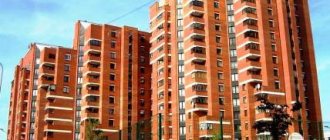About Khrushchev
When buying apartments of old buildings, many are faced with such a problem as the height of the ceilings in Khrushchev. In all residential buildings of this type it is standard and is 2.5 meters. Houses were usually built according to one design.
The problem in Khrushchev is that during renovation, not only the total area, but also the distance from the floor to the ceilings is significantly reduced. Housing becomes uncomfortable.
If you use suspended ceiling structures, combining them with floor insulation, then the ceilings of five-story buildings are significantly reduced in height. Moreover, problems with a tiny area begin already at the entrance, where the entrance doors of apartments on the landing practically touch.
The bathroom is often combined with a toilet. The total area of the bathroom is so small that it resembles a utility room. It is difficult for one person to turn around in such an area. It is difficult to imagine how a person of slightly above average height feels, with Khrushchev’s small ceilings. Of course, at such a height a discomfort arises.
It turns out that even small-sized apartments allow you to create a beautiful ceiling covering, despite the small standard height. So, hanging and tension structures are not suitable because they will reduce the small living space. The best option would be to wallpaper the ceiling covering, or lay special slabs made of polymer material.
If you really want a tension structure, then don’t despair. Even with standard apartment ceilings (2.5 m), you can install a structure with one level. To ensure that the living area does not decrease, the distance between the tension fabric and the main surface must be maintained (no more than 3 cm). You should not build lighting fixtures into the hanging structure, otherwise the volume of the room will also decrease.
Durability
Initially, such houses were intended as a temporary measure.
They were planned to be replaced with comfortable and spacious houses, but history decreed otherwise. In general, “Khrushchev” buildings are designed for 25 years of operation. There are also unbearable series, whose service life is 50 years or more. Recent studies have shown that, in fact, with timely repairs (including major ones), insulation and design improvements, such houses can serve their people for about 50 years. For unbearable series, this figure is 100-150 years.
Stalin's house
The ceilings of Stalin's houses are much different in height from Khrushchev's, 3 meters or higher (up to 3.5). Apartments of this type are spacious, bright, with a large number of utility rooms. As for the entrances, the landings are also spacious, with high spans and wide window openings.
In addition to the luxurious footage, Stalin buildings are distinguished by huge kitchens, wide hallways, spacious bathrooms, and the distance from floor to ceiling. A special feature of such houses is the non-standard layout of the apartments. The construction of Stalinist houses lasted about 30 years. The houses were built according to completely different designs. Therefore, the ceilings of Stalinist houses are different (from 3 to 4.5 meters).
So, there are one-room apartments with an area of 60 square meters. On the contrary, two-room apartments can be quite small (35 square meters). Still, the main difference between Stalinist houses can be called the height of the ceilings.
Vertical dimension definition
- Foundation + roof. The depth of the foundation is different everywhere. For example - 2.20 m. + 5 m. = 7.5 m. The height of the floor with ceilings is approximately 3 m. Then the height of the five-story building will be 22.5 m.
- If the house has no basement, and the vertical from the ground is 1.5 m. We calculate the height of each floor together with the ceiling - 15 m. We add the roof height (according to the standard 5 m.) We get 21.5 m.
- It would be easier to determine the height of a house if there was a standard vertical floor dimension. But there is no standard. Because there have always been different house designs. Some had a basement and a multi-pitched roof. Others with a semi-basement and attic. Houses were built with a basement and a high ground floor. Houses with a flat roof but with a 2.5m basement were also built.
- Therefore, on average, a really 5-story building is about 15 m long. It all depends on the thickness of the floor and the height of the floor.
- The very first brick houses could be 14 m high. The ceiling height was small - 2.40 m. By the way, in “Stalinist” houses the amount of air per person was taken into account. In the planning of “Khrushchev” buildings, in the early stages, they were not interested in such trifles.
- Soviet-era houses are a thing of the past. Along with them are standard projects with GOST standards, standard blocks and parts. Therefore, it is simply impossible to determine at what height the apartment is located if you do not know the design of the house. Therefore, a five-story building, taking into account the roof, can be from 22-28 m vertically.
The height of a five-story building. A variant of a standard house design with 2 entrances.
Brezhnevka
Brezhnevkas are standard high-rise buildings (5 and 9 floors) built from 1960 to 1980. Compared to the two previous types of residential buildings, the layout of such high-rise buildings has become improved. Elevators with garbage chutes appeared. The landings with flights have become a little more spacious when compared with the small landings of previous buildings.
As for the interior appearance of the living quarters, they have also changed. The combined bathrooms have disappeared; the bathrooms are equipped with waterproofing. The rooms of many houses have become separate rather than walk-through.
But the area of the kitchen, toilet and bathroom still remained small.
As for the height in Brezhnevka, the apartments have become taller, thanks to the improved layout of residential buildings. So, the ceiling of the Brezhnevka reaches 2.7 m. It seems that the difference is small. But, during repair work, even this difference becomes noticeable.
However, the ceilings of the 5-story Brezhnev-type houses remained similar to those of Khrushchev, their height is only 2.5 m. Five-story Brezhnev-type houses were built according to special designs. Thus, a variety of five-story buildings with a completely flat roof appeared. Due to such a project, funds allocated for construction were significantly saved. But such apartments with small kitchens and sanitary facilities are distinguished by small ceilings in the apartment.
Khrushchev series
The largest blocks of houses in the “old panel” category are mainly located in the Kirovsky, Krasnoselsky, Moskovsky, Kalininsky (Grazhdanka, Polustrovo), Krasnogvardeysky (Okhta) districts. Housing prices in them are the lowest in the city, although different series of Khrushchev buildings have different consumer demand.
Series 1-507, Kuznetsovsky DSK, Nevsky DSK
At the Kuznetsovsky and Nevsky plants, the first and most common type of five-story building was produced (every fourth Khrushchev building in the city belongs to this category) - 1-507, in the jargon of realtors “five hundred and seventh”. The first houses in the series appeared in 1956. Built before 1972. Wall material - aerated concrete panels.
Kitchens from 5.5 sq.m. (in one- and two-room apartments) up to 7 sq.m. (in 3-, 4-room apartments). All apartments have separate bathrooms. Two- and three-room apartments have adjacent rooms. But there is a balcony. There is a spacious storage room.
The first two experimental houses of the 507 series were built in 1956 in the Shchemilovka area. The largest array of buildings in the 1-507 series in St. Petersburg is located in one of the most expensive areas in terms of housing prices - Moscow (along the Vitebsk railway).
Among the houses in the “old panel” category, this series is considered the highest quality. There is good quality window carpentry and parquet in the rooms. Internal engineering networks are, of course, outdated, but they can be repaired or can be completely replaced.
Series 1-335, Polyustrovsky DSK
These five-story buildings were assembled from “lightweight” expanded clay concrete with mineral wool insulation. However, it soon became clear that a light “three hundred and thirty-five” was unacceptable for our weather conditions. Therefore, production, which began in 1959, was suspended in 1966.
The Kalininsky district of Leningrad became an experimental platform for testing this type of Khrushchev, therefore their main “habitat” is Grazhdanka.
The facades of the houses in this series are decorated with small ceramic tiles (mainly in blue tones). This makes them much more attractive in appearance, but inside there is the same minimalism as in any Khrushchev.
The “basic” layouts of apartments in buildings of the 1-335 series (four one-sided apartments per floor) are very similar to those used in the 507 series. There are also balconies and quite large storage rooms. However, in 1-335, the bathrooms in all apartments are adjacent, and the interior partitions several centimeters thick do not allow hanging either heavy bookshelves or kitchen cabinets.
Series OD, Obukhovsky DSK
Until 1963, this plant produced five-story panel buildings of the OD series. The material of the panels is the same expanded clay concrete as that of the 1-335 series. The main consumers of Obukhovsky DSK products are the Nevsky and Frunzensky districts.
In terms of heat loss, houses of the OD series “compete” only with 1-335. And they often lose even to them.
There are cramped combined bathrooms with an area of about 2 sq.m., and five-meter kitchens. Moreover, the thickness of the partitions in them is only four centimeters. There is no need to talk about any noticeable sound insulation inside the apartment (between the kitchen and rooms).
GI series, Avtovsky DSK
Houses in this series were built from 1959 to 1968. The external walls are made of lightweight aerated concrete panels. The walls were not decorated with anything - just painted slabs. There are no balconies. There are no one- and two-room apartments.
Typical three-room apartment: two bedrooms (6 and 9 sq.m.), living room (15 sq.m.), combined bathroom - 2.2 sq.m., hallway with built-in wardrobe and kitchen (5.5 sq.m. ), total area is about 43 sq.m. Entrance to the kitchen from the common room - living room. The ceilings in the bathrooms are only 2.3 m. The layout of a four-room apartment is no different from a three-room apartment.
Most of these houses are located in the Kirovsky, Moskovsky and Krasnoselsky districts.
The disadvantage of this series is that the houses are too cold in winter, and very hot in summer, therefore, it is necessary to insulate the external walls. However, since the adoption of the resolution “On the Regional Program for the Reconstruction of Residential Buildings of the First Mass Series” (2000), only a few buildings of the GI series have been subjected to the necessary rehabilitation in St. Petersburg. A typical example is houses No. 34, 36 on the street. Chervonny Cossacks. They were sanitized without relocating residents. The walls are insulated and decorated, the “carpentry” has been replaced with metal-plastic, and the plumbing has been completely replaced.
It should be noted that the building materials from which the GI series houses were assembled contained a significant content of asbestos, which is unsafe for health.
The panel is growing
Since the beginning of the 70s, the second stage of industrial housing construction began in the country. Panel houses began to grow upward - from five-story buildings, the plants moved to the construction of 9-, 12-, 15-story buildings. These buildings, due to their belonging to another historical era, are today called Brezhnevka. But, unlike Khrushchev buildings, housing built in the 70s and early 80s is much more “variegated”. Some series of Brezhnevkas are today considered high-quality and comfortable housing, while others are not rated at all. For example, an apartment in a “ship” is often valued lower than an apartment in a five-story building of the GI series.
Assembly technologies, wall materials, and layouts of many series of Brezhnevkas can be considered obsolete. Therefore, realtors classify them as “old panels”, just like Khrushchev buildings. Among them are the 1-LG-600 series (the referred to “ship”), the 1-LG-504 series and a number of their modifications.
Discreet humanity
In contrast to the Khrushchev buildings, the residential developments of the 1970s and early 1980s are much more diverse. Housing in houses of some series of those years is today considered good and comfortable. However, a significant part of the Brezhnevkas are just improved Khrushchevkas. Until the turn of the 1960s and 70s, house-building factories (DSK) were forced to strictly follow the resolution of the USSR Council of Ministers “On the elimination of excesses in design and construction.”
However, later the authorities took pity on the citizens. In 1969, the country's leadership set builders the task of “raising the artistic, aesthetic and operational level of housing.”
Thanks to the new policy in the field of housing construction, DSK received a certain freedom in the choice of materials, technologies, and room layout.
However, the conveyor, launched ten years ago, was not easy to knock off the established ri Brezhnevkas grew to nine floors, but were assembled from the same gas- or expanded clay concrete panels and, most importantly, in the same Stakhanovist rush. At that time, the USSR was the leader in housing construction across the entire continent, but quantity, of course, harmed quality.
However, there have been some achievements. For example, the designers managed to slightly “raise” the ceilings - from 2.5 to 2.7 m, and expand the kitchen area - from 5 to 7 sq.m. (in later modifications the kitchen reached 13.5 sq.m.). In these houses, components of comfortable living that were inaccessible to the inhabitants of Khrushchev also appeared - elevators and garbage chutes.
Brezhnev series
Historical 1966 - The Council of Ministers of the USSR approved the General Plan for the Development of Leningrad. The plan determined the prospects for housing and civil construction, development of transport and engineering communications of the city for 20 years in advance. It was this plan that established development priorities, as a result of which new areas gradually appeared on the city map, without which it is no longer possible to imagine present-day St. Petersburg: Grazhdanka, North of Murinsky Stream, Shuvalovo-Ozerki, Ulyanka, Sosnovaya Polyana, South-West, Kupchino, former Komendantsky airfield, Rzhevka-Porokhovye.
These territories became the main “consumers” of the products of the Leningrad DSK of the second stage of industrial housing construction. The first Khrushchev series were replaced in the late 1960s by a series of nine-story buildings.
Series 1LG-504 and 1LG-504D – a housewife’s dream
Produced at DSK-4 - formerly Kuznetsovsky DSK.
When it comes to a specific series, the geographical location of the building arrays is easy to guess by the name DSK. But not in the case of series 504. These nine-story panel buildings in St. Petersburg were built in almost all districts.
First, DSK-4 carried out modernization and switched from the production of five-story buildings of the 507 series to nine-story buildings of the 504th series. Then he began to produce a modification of this building - 1LG-504D.
The apartments in 504 are the smallest among all the early Brezhnev buildings. The area of a 3-room dwelling is only 58 sq.m., which is not much more than in a Khrushchev-era building.
From its predecessor, the Khrushchev-era 507 series, the nine-story building inherited parquet floors, which is a clear advantage, since at that time DSK switched to cheap artificial linoleum. If in the buildings of the 507th two- and three-room apartments had balconies, then in the nine-story building of the Kuznetsovsky production, the two- and three-room apartments are equipped with a full-fledged loggia, as well as a built-in wardrobe. Some one-room apartments have balconies, some don’t (depending on your luck here). Both in Khrushchev and early Brezhnevkas, a separate bathroom is a rarity.
Series 504D - a modification of the first "Kuznetsov" nine-story building, in which the builders actually took into account the order of the Council of Ministers - somewhat increased the aesthetic and operational qualities of the building.
At least the designers created a layout that remained in the folklore of that time as a “housewife’s dream.” The one-room apartments of the improved 504th now have kitchens with an area of 13.2–13.5 sq.m. The size of the hallway has also increased somewhat. In addition, the bathroom has a small vestibule for installing a washing machine. In two-room apartments, the kitchen is slightly smaller (11.5–11.8 sq.m.), but there are two loggias.
Unlike the standard series, its “humanized” version was built only in the Primorsky region: at the Komendantsky airfield and in the Kamenka area.
Series 1-LG-602. Without amateur performances
The Obukhovsky DSK took up the development of this series in 1966. The Khrushchev OD series, previously produced by this plant, did not evoke applause from the top leadership of Leningrad. Already in 1963, the plant received the status of an experimental demonstration enterprise. As a result, DSK-2 (Obukhovsky was merged with Polyustrovsky) opened a production line for nine-story buildings of the 602 series.
After a series of experiments, the plant launched a new series of high-rise buildings for those times. In 1966, the DSK-2 conveyor began churning out the 602nd. The main development zones are Kupchino and Nevsky district.
Popular magazines, praising the new series, emphasized “the use of new finishing materials - ceramics, glass tiles, polymers.” As the new residents found out, the finishing innovation consisted of replacing wooden parquet with polymers, that is, artificial linoleum.
The main disadvantages of this series are the lack of storage rooms and inconvenient kitchens. They (7 sq.m.) are sandwiched between the outer wall and a monolithic plumbing cabin. Therefore, the occupant does not have the opportunity to “play” with the areas of the premises - redevelopment is excluded. But there are separate bathrooms in all apartments (in all types of 504 this was still considered an excess).
Apartments in buildings of the 1-602 series are comparable in price to apartments in five-story panel buildings. At the same time, the quality is noticeably higher. If only because the walls and ceilings are more massive.
Series 1-LG-606. Operation Cooperation
Of all the Brezhnev panel buildings of the second stage of industrial panel housing construction, the 606th series is the warmest and most comfortable housing. Not without its shortcomings, however. Since the buildings were not built, but assembled on a conveyor belt, the quality of sealing of joints during the large-panel assembly process leaves much to be desired.
This series would have become just as derivative of the Khrushchev buildings if the Leningrad authorities had not handed over the 606th to housing construction cooperatives. The predecessors of today's share construction participants built some pretty good houses. They are the warmest and most comfortable of all the new buildings of the “first wave” of the Brezhnev era.
Hollow-core floors provide good sound insulation. Thick exterior walls and large windows with wide sills greatly reduce the effects of cold and drafts.
Houses of the 606th series are presented in the area of Lake Dolgoe, near the Ozerki metro station, in Kupchino, Veseloy Poselok, on Grazhdanka, in the South-West and a little in the Moskovsky district. Consequently, they are all located in lived-in, green neighborhoods with good transport links.
New building
When constructing new houses, different standards are applied. Therefore, in new buildings the height parameters may be different. Luxury residential premises are built according to special projects, so apartment surfaces can reach 3 meters. Accordingly, the cost per square meter of living space increases.
Budget options for new houses are being built, where the ceiling in the room is 2.7 meters high. This option is considered optimal in terms of living comfort, including the financial side of the issue.
Ceilings in monolithic new buildings can be 3 meters high. But, more funds are spent on such a project, and the cost increases accordingly. The high cost of apartments is explained by the high consumption of materials.
The average standard value in a new type of apartment is considered to be a height of 2.6 to 2.8 m.
Panel house
Panel construction is still popular today. The series of projects of such residential buildings differ in the number of floors and the area of residential premises.
Ceilings in panel houses can vary in height (2.5 - 2.7). This parameter depends on the year the building was built, the square footage of the apartments, and the materials from which the building was built.
For example, the ceilings in a Khrushchev panel building may not reach the height of 2.5, and amount to 2.48 m. In such apartments, it is problematic to decide on the choice of ceiling covering.
Standard parameters in a panel house vary in height from 2.48 to 2.71 m.
In different years of construction, residential buildings were erected according to different projects. The houses differed in the number of apartments on the landing, the width of the window openings, and the internal layout of the living quarters.
Thus, the parameters of the apartment ceilings of a panel house depend on the number of storeys and the material with which the building is constructed.
House 9 floors
Panel houses with 9 floors have solid parameters, and the ceilings there are 2.64. This is already the optimal height. But such parameters began to be used only until 1995. Later, more economical designs began to be used in the construction of residential buildings.
But, if we talk about the standards of brick nine-story buildings of Stalin's times, then the distance from the floor to the ceiling space, in some projects, reached 4 meters. Elite Stalinist buildings had apartments with ceilings of 4.5 meters.
The distance from floor to ceiling in a 9-story panel house depends on the year of construction and the project. So, for Khrushchev’s buildings the height will be 2.5 meters, while for Brezhnev’s it varies from 2.64 to 2.7.
House 5 floors
Standard standards for ceilings in a panel house of 5 floors could be different. The parameter depends on the project series, year of construction, and internal layout.
As mentioned above, in the Khrushchev panel building the height was only 2.5 meters.
Houses of the Brezhnev years were distinguished by improved layout and comfort. In such apartments the standards reached 2.64 and even 2.7.
Today, the most optimal parameter for the average standard of apartment ceilings is considered to be 2.7 meters.
History of the term and mass construction
The term was introduced by the name of the country's leader, and the trend was set from the moment when economy options began to appear next to earlier buildings. Those quickly built, with the hope of subsequent replacement, were called Khrushchev buildings. Previously, “Stalinka” buildings were built - functional, comfortable, designed for long-term use; they were designed under Stalin.
The houses, built within the strict limits of amenities and resources, were built with the goal of relocating barracks and communal apartments as quickly as possible.
The state's plans included the intention of providing each family with its own individual space and separate housing.
It is sometimes mistakenly believed that this name refers only to modifications of five-story panel buildings. This misconception is based on SNiP, developed in 1958, specifically for prefabricated series, in order to limit the concepts and norms of compliance with state standards. Initially, two-, three-story, and 4-story buildings of the following types were built:
According to the existing housing construction standards, houses of 5 floors could still do without an elevator, which in other options took up a significant part of the allocations not only for the arrangement system and the necessary mechanisms, but also for subsequent repairs and maintenance.
The beginning of the era of Khrushchev apartment buildings
The first experimental options were built back in 1948, in Moscow, Leningrad and Magnitogorsk, but over time it was discovered that frame-panel houses were much more expensive. Since 1958, dense construction of houses began, quickly assembled from standard panel parts. This made it possible to simultaneously build entire neighborhoods, and often residential neighborhoods for future happy new residents.
The creation of the Unified State Catalog of Construction Parts has greatly facilitated the development of new projects, and the introduction of building codes and regulations has made them safer. In large settlements, people received apartments in Khrushchev-panel buildings.
For the production of building materials, special enterprises were opened, from which delivery was carried out directly to the construction site. This was beneficial to both enterprises and the state. In remote villages and small towns there was no point in building such factories due to small volumes, and their delivery by road over long distances was expensive and unprofitable.
An alternative option was found in brick Khrushchev buildings, quickly erected from sand-lime brick. It was much cheaper than concrete panels, as was the construction of a small brick factory that served the needs of a limited area.
The ceiling height in a Khrushchev building is not an average value, the same for all numerous projects developed on the basis of the existing Unified Catalog of Construction Parts. This is the parameter defined:
- the series to which the planned house fell;
- manufacturing material (brick or standard panels);
- year of construction (it is believed that Khrushchev buildings were built from 1958 until 1985, although there are still professional disputes over the terminology);
- made design changes (additions and changes could be made to the series, which was accompanied by appropriate markings);
- place of construction (in young and rapidly developing cities, allocated funds could be even more limited due to the need to build millions of square meters of housing).
So, what is the height of the ceilings in a Khrushchev building is not one standard parameter that can be found in a reference book on the history of construction. It is necessary, first of all, to know the series number to which the house belongs, the year it was built, the number of floors (4 floors or five).
Of no small importance for determining the ceiling height in an apartment located in the category of these houses is the construction material (sand-lime brick from which the Khrushchev building was erected, or standard concrete panels, large blocks made at the city reinforced concrete products factory.
Minimum ceiling height
When constructing residential buildings, various parameters are taken into account, including the minimum distance from floor to ceiling that a residential building can have.
So, in brick Khrushchev-era buildings, the ceilings could not be less than 2.5 meters. The same minimum parameter applies to buildings made of panels. Although, to reduce costs, the distance from floor to ceiling in a Khrushchev-type panel house could be only 2.48 meters, as mentioned above.
The ceiling height standard of a minimum level of 2.5 meters is used in modern construction. At the same time, the overall construction costs are reduced and the cost per square meter is reduced. This option is considered optimal. But during renovation work you have to work hard if you plan to finish the ceiling space.
Characteristics
The costs are divided into 2 types:
- uncomfortable five-story buildings;
- more comfortable, mostly 9-story buildings.
Each type of house of this era should be analyzed, as they carried changes that characterized their decades.
The first type is small-sized five-story buildings. Already from the name it is clear that there was no talk about comfort. The urgent need of the people for housing forced the government to solve this issue quickly and on a national scale.
Important! How to make a ceiling in the hallway with your own hands
For this reason, functionalism and minimalism have become the main slogans in the construction and design of houses. Priority was given to construction from panels and solid blocks. In rare cases, sand-lime brick was used.
This is explained by the speed of construction. It is much faster and easier to install panels and floors from solid blocks, and if you consider that such construction was carried out throughout the country, the sacrifice of quality in exchange for speed and cheapness becomes clear.
However, not all cities had enterprises that produced such panels. It was too expensive to deliver them from other cities. For this reason, projects were developed for the construction of “Khrushchev” buildings made of sand-lime brick. Its production was faster, cheaper, and transportation was much easier.
Undoubtedly, such measures entailed a lot of negative consequences. One of the first and most noticeable is poor heat and sound insulation. In Russian frosts, corner apartments of panel houses could freeze significantly, and neighbors’ conversations could be heard throughout the entire corridor (we are talking about a calm conversation).
Floors 4 and 5 were not chosen randomly. In accordance with all regulations, this was the maximum construction height at which it was not necessary to install an elevator, which was simply an unthinkable luxury in all-Union construction.
A little later, the government took at least a little care of the comfort of citizens, and some series of houses were equipped with a garbage chute.








